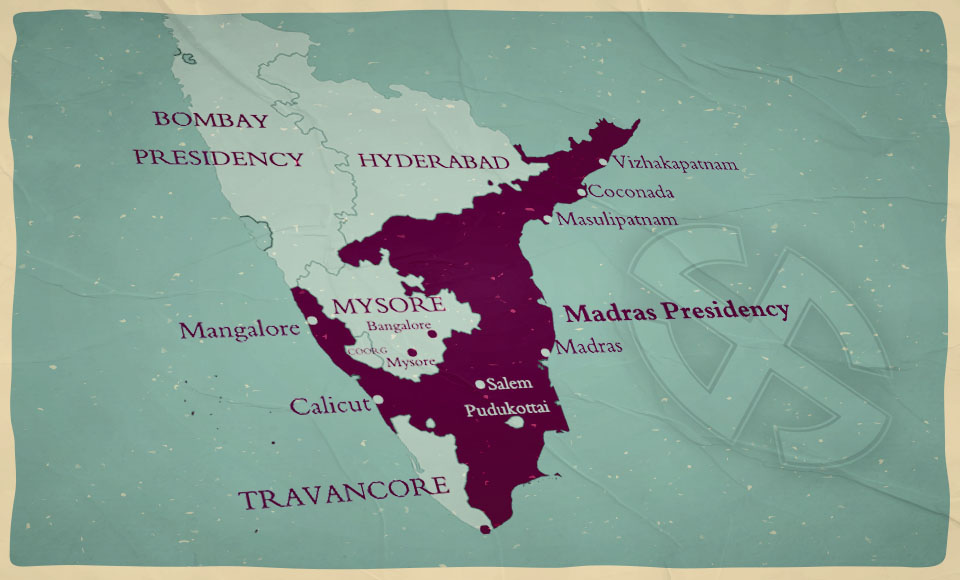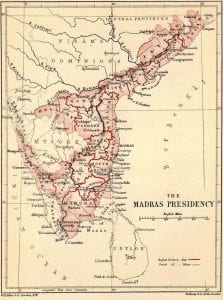
- Home
- News
- Analysis
- States
- Perspective
- Videos
- Education
- Entertainment
- Elections
- World Cup 2023
- Features
- Health
- Business
- Series
- Economy Series
- Earth Day
- Kashmir’s Frozen Turbulence
- India@75
- The legend of Ramjanmabhoomi
- Liberalisation@30
- How to tame a dragon
- Celebrating biodiversity
- Farm Matters
- 50 days of solitude
- Bringing Migrants Home
- Budget 2020
- Jharkhand Votes
- The Federal Investigates
- The Federal Impact
- Vanishing Sand
- Gandhi @ 150
- Andhra Today
- Field report
- Operation Gulmarg
- Pandemic @1 Mn in India
- The Federal Year-End
- The Zero Year
- Premium
- Science
- Brand studio
- Home
- NewsNews
- Analysis
- StatesStates
- PerspectivePerspective
- VideosVideos
- Entertainment
- ElectionsElections
- Sports
- Loading...
Sports - Features
- BusinessBusiness
- Premium
- Loading...
Premium

On Madras Day, a tale of the first election and 'funny politics'

Much before India attained Independence, Madras Presidency was a large swathe of land that included the present-day states of Tamil Nadu, Andhra Pradesh and parts of Karnataka and Kerala (the Malabar region). It, however, excluded the princely states of Puducottai, Banganapalle and Sandur. Madras Presidency. Source: Wikipedia The capital of this diverse and rich presidency was Madras...
Much before India attained Independence, Madras Presidency was a large swathe of land that included the present-day states of Tamil Nadu, Andhra Pradesh and parts of Karnataka and Kerala (the Malabar region). It, however, excluded the princely states of Puducottai, Banganapalle and Sandur.

The capital of this diverse and rich presidency was Madras city, where the first elections took place a little under a 100 years ago. On the occasion of Madras Day, let’s take a look at how the first election panned out in pre-Independent Madras.
Background to the elections
In 1919, the government had passed the Montagu-Chelmsford reforms. These reforms brought in what was known as dyarchy. It was a system of governance where some matters or ‘reserved subjects’ such as defence and finance remained with the British and others, known as transferred subjects, were to be handled by Indians. The transferred subjects included local affairs, agriculture and matters that the British felt Indians would be better off dealing with.
However, the actual reason for these reforms was Britain’s promise of providing good governance under its Empire, as compensation for involving thousands of Indians in the World War I. They were also brought about because the provinces wanted to govern themselves, and outfits like the Congress wanted to involve Indians more in their own governance.
The first election
Only 3 per cent of the population — those owning land or paying taxes — were allowed to vote in the 1920 elections. The Justice Party and the Congress were the two main parties in the Madras Presidency. However, months before the election, Mahatma Gandhi called for non-cooperation. This threw the Congress out of the race, which essentially meant its members had to remain outside the Legislature.
As a result, the Justice Party swept the polls. The members from Madras city included two Justice Party candidates and two independents. P Thyagaraya Chetty, the president of the Justice Party; O Thanikachallam Chetty, a Justice Party member; Dr U Rama Rao, a doctor from Canara; and CP Ramaswamy Iyer (he would be the youngest Advocate General of Madras that year, at 41).
Despite Gandhi’s call for a boycott of the elections, only six seats across the British territories remained uncontested.
The concept of constituencies did not exist then. Members were elected by districts with some voting in even four or five. Some of the seats were reserved — 13 seats for Muslims, five for Christians, six for landowners, one European, one planter, five commerce seats and one university seat.
The Madras Legislative Council was declared open by Prince Albert, the Duke of Connaught and Stratheam, in 1920. He toured India, declaring the various Legislative Councils open, before going to Delhi in 1921, and laying the foundation stone for Parliament buildings, and declaring the Assembly open. The Centre was a two-house body: the Assembly and the Council of States. The Assembly, like the Provincial Council, had a three-year term.
Justice Party reign
Although A Subbarayalu Reddiar was the first First Minister (equivalent of a chief minister), he soon resigned due to ill health, and P Ramarayaningar was sworn in. He would soon inherit a title that would eclipse his name: Raja of Panagal.
Panagal, who became the party president following the death of Thyagaraya Chetty in 1925, would continue as the First Minister until 1926. His tenure came to an end when the Swaraj Party, a party of Congressmen who were determined to fight the elections despite the Congress’s stance, defeated them in the third elections in 1926.
It was under Panagal that the idea for T Nagar began, and women got to vote in Madras (the first British province to do so) in 1921 — the first major act passed. Women would not vote in the Centre until 1934.
However, the Congress was against the Swarajists forming a government. So, an independent ministry under Dr Subbarayan was constituted. In the 1930 elections, the Justice Party returned to power under B Munuswamy Naidu following Panagal’s death in 1928. This was because the Swarajists were instructed to stay away from the elections following the policy of Civil Disobedience by the Congress.
However, due to infighting, Naidu was replaced by the Raja of Bobbili in 1932. In 1934, the Justice Party lost yet again. However, Bobbili was allowed to continue with a minority government, as the Swarajists were still not allowed to form a government. The following year, the Government of India Act 1935 came into force.
The new act
The Government of India Act 1935 abolished dyarchy and brought in provincial autonomy. There would be a Premier with a council of 10 ministers. The number of nominated members was reduced. The Governor still remained the head of the province, and still held veto power.
The percentage of voters was now up to 14 per cent of the population. The electoral rolls were prepared in local languages, except in cities and European and anglo-Indian constituencies, where they were in English.
People could only vote if their names were on the electoral roll. Everyone was given two weeks to send in a notice to be included on the rolls, with their qualifications for voting. Husbands would have to apply on behalf of their wives. In an electoral roll, a person’s name, father or husband’s name, surname, residence and nature of qualification had to be specified.
Constituencies were now introduced, and most were single-member constituencies, with a few exceptions. The Congress was hesitant about the new act, but decided to contest the elections.
Justice Party loses out
The Congress swept the 1937 Madras Presidency Legislative Assembly election. C Rajagopalachari was made the premier, but it took the Congress two months to clear his name for the post. In the meantime, the Governor had set up his own government.
Rajaji’s ministry and all other Congress ministries resigned in 1939 over the inclusion of India in the World War II without consulting the Legislature.
Elections were held again in 1946, and due to internal party politics, the chief minister changed three times before the first general elections. The chief minister at the time of Independence was OP Ramaswamy Reddiar. After Independence, the Congress stayed on for a while before being ousted by regional parties.
It is interesting to note that people and politics fundamentally don’t change. The first government was all for dyarchy, but once in power, with no control over finance and seeing the problems it caused, they turned against it. They diluted their own agenda (the non-brahmin movement) by allowing brahmins into the party in 1930.
Justice Party members were known for nominating their friends to local positions, and not allowing elections. This is not to say the Congress was a saintly organisation. The Congress members fought one another for posts when in power, for power.
Governor John Erskine once commented, “I thought I knew something about playing funny politics, but I must take my hat off to these Indians.”
(Nandan is a history student currently pursuing his graduation at Ashoka University.)

